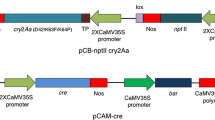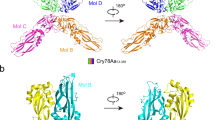Abstract
In order to improve the insecticidal activity, the chitinase gene from tobacco (Nicotiana tabacum) endochitinase and the cry1Ac gene from Bacillus thuringiensis were cloned into the vector pHT315 and designated as pHUAccB5 plasmid. The constructed transcriptional fusion was attempted under the control of the native cry1Ac promoter. Plasmid pHUAccB5 was introduced into B. thuringiensis acrystalliferous by electroporation. Analyzed by sodium dodecyl sulfate-polyacrylamide gel electrophoresis and Western blot, the transformant XBU-HUAccB5 produced 130–kDa Cry1Ac protein and 30-kDa chitinase protein. During the chitinase active analysis, the transformant, XBU-HUAccB5 chitinase active, reached 7.5 U/mL at 72 h, and was 5 times higher than the HTX-42 and 6 times higher than the parent strains. When the insecticidal activity of the transformant was evaluated against Helicoverpa armigera Hubner, the XBU-HUAccB5 toxicity was 11.30 times higher than the transformant HTX-42 expressed single cry1Ac at 48 h and was 18.76 times higher at 72 h.


Similar content being viewed by others
References
Adang MJ, Staver MJ (1985) Characterized full-length and truncated plasmid clones of the crystal protein of Bacillus thuringiensis subsp. kurstaki HD-73 and their toxicity to Manduca sexta. Gene 36:289–300
Agaisse H, Lereclus D (1995) How does Bacillus thuringiensis produce so much insecticidal crystal protein? J Bacteriol 177:6027–6032
Alejandra B, Gill SS (2007) Mode of action of Bacillus thuringiensis Cry and Cyt toxins and their potential for insect control. Toxicon 49:423–435
Barboza CJ, Nieto ME (2003) Cloning, sequencing, and expression of the chitinase gene chiA74 from Bacillus thuringiensis. Appl Environ Microbiol 69:1023–1029
Gill SS, Cowles EA, Pietrantonio PV (1992) The mode of action of Bacillus thuringiensis endotoxins. Annu Rev Entomol 37:615–636
Höfte H, Whiteley HR (1989) Insecticidal crystal proteins of Bacilllus thuringiensis. Microbiol Rev 53:242–255
Ito T, Ikeya T, Sahara K (2006) Cloning and expression of two crystal protein genes, cry30Ba1 and cry44Aa1, obtained from a highly mosquitocidal strain, Bacillus thuringiensis subsp. entomocidus INA288. Appl Environ Microbiol 72:5673–5676
Jong YR, Kyung SB, Yeon HJ (2004) Expression of a recombinant Cry1Ac crystal protein fused with a green fluorescent protein in Bacillus thuringiensis subsp. kurstaki Cry-B. Microbiology 42:340–345
Lehane MJ (1997) Peritrophic matrix structure and function. Annu Rev Entomol 42:525–550
Lereclus D, Arantes O (1989) Transformation and expression of a cloned delta–endotoxin gene in Bacillus thuringiensis. FEMS Microbiol Lett 51:211–217
Lertcanawanichakul M, Wiwat C (2004) Expression of chitinase-encoding genes in Bacillus thuringiensis and toxicity of engineered B. thuringiensis subsp. aizawai toward Lymantria dispar larvae. Curr Microbiol 48:175–181
Lysenko O (1976) Chitinase of Serratia marcescens and its toxicity to insects. J Invertebr Pathol 27:385–386
Maagd D, Bravo RA (2001) How Bacillus thuringiensis has evolved specific toxins to colonize the insect world. Trends Genet 17:193–199
MacIntosh SC, Sone TB (1990) Specificity and efficacy of purified Bacillus thuringiensis proteins against agronomically important insects. J Invertebr Pathol 56:258–266
Morris ON (1976) A 2-year study of the efficacy of Bacillus thuringiensis-chitinase combinations in spruce budworm (Choristoneura fumiferana) control. J Can Entomol 108:3225–3233
Regev A, Keller M, Strizhov N (1996) Synergistic activity of a Bacillus thuringiensis delta-endotoxin and a bacterial endochitinase against Spodoptera littoralis larvae. Appl Environ Microbiol 62:3581–3586
Shinshi H, Mohnen D (1987) Regulation of a plant pathogenesis-related enzyme: Inhibition of chitinase and chitinase mRNA accumulation in cultured tobacco tissues by auxin and cytokinin. Proc Natl Acad Sci U S A 84:89–93
Smirnoff WA (1973) Results of test with B. thuringiensis and chitinase on larvae of spruce bud worm. J Invertebr Pathol 21:116–118
Smirnoff WA (1974) Three years of aerial field experiments with Bacillus thuringiensis plus chitinase formulation against the spruce bud worm. J Invertebr Pathol 24:344–348
Tsujibo H, Yoshida Y (1992) Purification, properties, and partial amino acid sequence of chitinase from a marion Alteromonas sp. strain O-7. Can J Microbiol 38:891–897
Tsujibo H, Minoura K (1993) Purification and properties of a thermostable chitinase from Streptomyces thermoviolaceus OPC-520. Appl Environ Microbiol 59:620–622
Yang C, Zhu Y (1996) Molecular cloning and characterization of the Coccidioides immitis complement fixation chitinase antigen. Infect Immun 64:1992–1997
Acknowledgments
This research was supported by the National Natural Science Foundation of China (No: 30670052), the National 863 Project of China (No: 2006AA02Z187; 2006AA10A212), and the Research Fund for the Doctoral Program of Higher Education (No: 20060542006).
Author information
Authors and Affiliations
Corresponding author
Additional information
Xuezhi Ding and Zhaohui Luo contributed equally to this work.
Rights and permissions
About this article
Cite this article
Ding, X., Luo, Z., Xia, L. et al. Improving the Insecticidal Activity by Expression of a Recombinant cry1Ac Gene with Chitinase-Encoding Gene in Acrystalliferous Bacillus thuringiensis . Curr Microbiol 56, 442–446 (2008). https://doi.org/10.1007/s00284-008-9112-1
Received:
Accepted:
Published:
Issue Date:
DOI: https://doi.org/10.1007/s00284-008-9112-1




